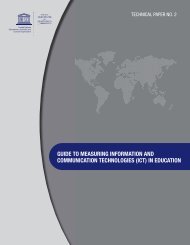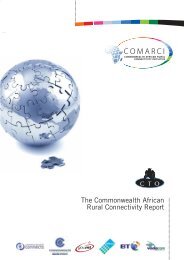ict in agriculture - Commonwealth Telecommunications Organisation
ict in agriculture - Commonwealth Telecommunications Organisation
ict in agriculture - Commonwealth Telecommunications Organisation
You also want an ePaper? Increase the reach of your titles
YUMPU automatically turns print PDFs into web optimized ePapers that Google loves.
SECTION 1 — OVERVIEW OF ICT IN AGRICULTURE: OPPORTUNITIES, ACCESS, AND CROSS-CUTTING THEMES 27<br />
BOX 2.7: Mobile Phones with Features Attract Rural Users <strong>in</strong> Ch<strong>in</strong>a and Beyond<br />
Ch<strong>in</strong>ese mobile phone producers are concentrated <strong>in</strong> the city of Shenzhen, Guangdong Prov<strong>in</strong>ce. They, as well as their<br />
products, have become known as shanzhai. a At least two <strong>in</strong>novative features associated with shanzhai devices have<br />
wider relevance to rural consumers’ use of, and preferences for, devices <strong>in</strong> develop<strong>in</strong>g countries.<br />
The first feature is that they allow users to store multiple (physical) SIM cards with<strong>in</strong> the device, which allows them to<br />
switch between carriers without hav<strong>in</strong>g to reboot the device. This feature responds to the price sensitivity of rural consumers<br />
<strong>in</strong> develop<strong>in</strong>g countries, who switch between carriers to take advantage of preferential term<strong>in</strong>ation rates for the<br />
carrier of their call<strong>in</strong>g dest<strong>in</strong>ation. Because the choice of mobile network operator can be limited <strong>in</strong> rural areas, consumers<br />
have strong <strong>in</strong>centives to take advantage of cost-sav<strong>in</strong>g opportunities when they exist. This demand-driven <strong>in</strong>novation<br />
has made no <strong>in</strong>roads <strong>in</strong>to the products of popular mobile phone manufacturers, which are reluctant to underm<strong>in</strong>e the<br />
bus<strong>in</strong>ess models of mobile network operators worldwide. Consumers who cannot purchase these devices can achieve<br />
the same results through street-level hack services offer<strong>in</strong>g software to configure from 6 to 16 SIM card identities on one<br />
physical SIM card, enabl<strong>in</strong>g users of unlocked mobile phones to switch conveniently among carriers.<br />
A second feature of devices from Ch<strong>in</strong>ese mobile phone manufacturers (relevant to convergence <strong>in</strong> the “<strong>in</strong>focom” sector)<br />
is the addition of analog television reception. This feature is found <strong>in</strong> phones with large LCD screens like those of<br />
smartphones.<br />
The features <strong>in</strong> these devices illustrate ways that the global mobile phone <strong>in</strong>dustry could choose to respond to the<br />
demands and constra<strong>in</strong>ts of rural consumers—but has not. The preference of rural consumers <strong>in</strong> develop<strong>in</strong>g countries for<br />
access to television over radio is well established but constra<strong>in</strong>ed by poor access to the electricity grid. Unlike dedicated<br />
radio receivers, television sets have not evolved to operate on dry cell battery power alone, and mobile phone devices<br />
with analog television functionality are the exclusive option for rural populations. Given that television rema<strong>in</strong>s an effective<br />
means of deliver<strong>in</strong>g agricultural extension messages, the lack of support for these and other <strong>in</strong>novative features<br />
<strong>in</strong>troduced by Ch<strong>in</strong>ese phone manufacturers represents a missed opportunity <strong>in</strong> rural communication.<br />
Source: Authors; Chipchase 2010; Abbey-Mensah 2001.<br />
(a) Shanzhai signifies Ch<strong>in</strong>ese imitation and pirated brands and goods, particularly electronics (http://en.wikipedia.org/wiki/Shanzhai, accessed July 2011).<br />
through connectivity providers, content creators and dissem<strong>in</strong>ators,<br />
<strong>in</strong>formation <strong>in</strong>termediaries, social facilitators, <strong>in</strong>formation<br />
literacy educators, and the governance channels steer<strong>in</strong>g<br />
the performance of these services. 19 Concerns with rural<br />
content have traditionally been alien to public policies aimed at<br />
universal service and universal access, but the convergence of<br />
the mass media and telecommunications sector, as well as the<br />
rise of the <strong>in</strong>formation society, make such concerns <strong>in</strong>creas<strong>in</strong>gly<br />
prom<strong>in</strong>ent and crucial to unleash<strong>in</strong>g a virtuous cycle of ICT<br />
adoption and use <strong>in</strong> rural areas. The delivery of content-based<br />
agricultural services is discussed <strong>in</strong> Topic Note 2.4.<br />
The service layer reflects the synergies (or lack thereof)<br />
among network <strong>in</strong>frastructure, connectivity modalities, access<br />
devices, and content. The dynamics of the worldwide content<br />
marketplace po<strong>in</strong>t to the dy<strong>in</strong>g out of traditional communications<br />
bus<strong>in</strong>ess models, which centered on tariffs anchored <strong>in</strong><br />
19 See the earlier discussion of the layered nature of access<br />
(“Access Concept”) and the Access Ra<strong>in</strong>bow Framework.<br />
ECONOMIC AND SECTOR WORK<br />
use time, quantity of data transferred, or communications distance<br />
covered. Such models <strong>in</strong>creas<strong>in</strong>gly are replaced by more<br />
flexible subscription models and models centered on realized<br />
<strong>in</strong>teractions and transactions, paid for via micropayments. In<br />
develop<strong>in</strong>g countries, where consumers are more price sensitive<br />
and less will<strong>in</strong>g to pay, the trend toward micropayments<br />
poses a considerable challenge to content and value-added<br />
service providers. The challenge is compounded by the marg<strong>in</strong>al<br />
success of government and donor efforts to provide<br />
content-driven rural services <strong>in</strong> develop<strong>in</strong>g countries.<br />
Traditionally, rural <strong>in</strong>formation services focused on provid<strong>in</strong>g<br />
broadcast<strong>in</strong>g (“push”) content, such as rural radio programm<strong>in</strong>g,<br />
but the ubiquity of mobile devices enables the<br />
sourc<strong>in</strong>g and shar<strong>in</strong>g (“pull”) of rural content. The presence<br />
of mobile technology as an author<strong>in</strong>g tool <strong>in</strong> rural areas presents<br />
an untapped opportunity to engage rural users <strong>in</strong> author<strong>in</strong>g<br />
content, thereby <strong>in</strong>creas<strong>in</strong>g the demand for exist<strong>in</strong>g rural<br />
<strong>in</strong>frastructure. Mobile devices, <strong>in</strong> comb<strong>in</strong>ation with broadcast<strong>in</strong>g<br />
technologies such as radio, enable rural residents to

















